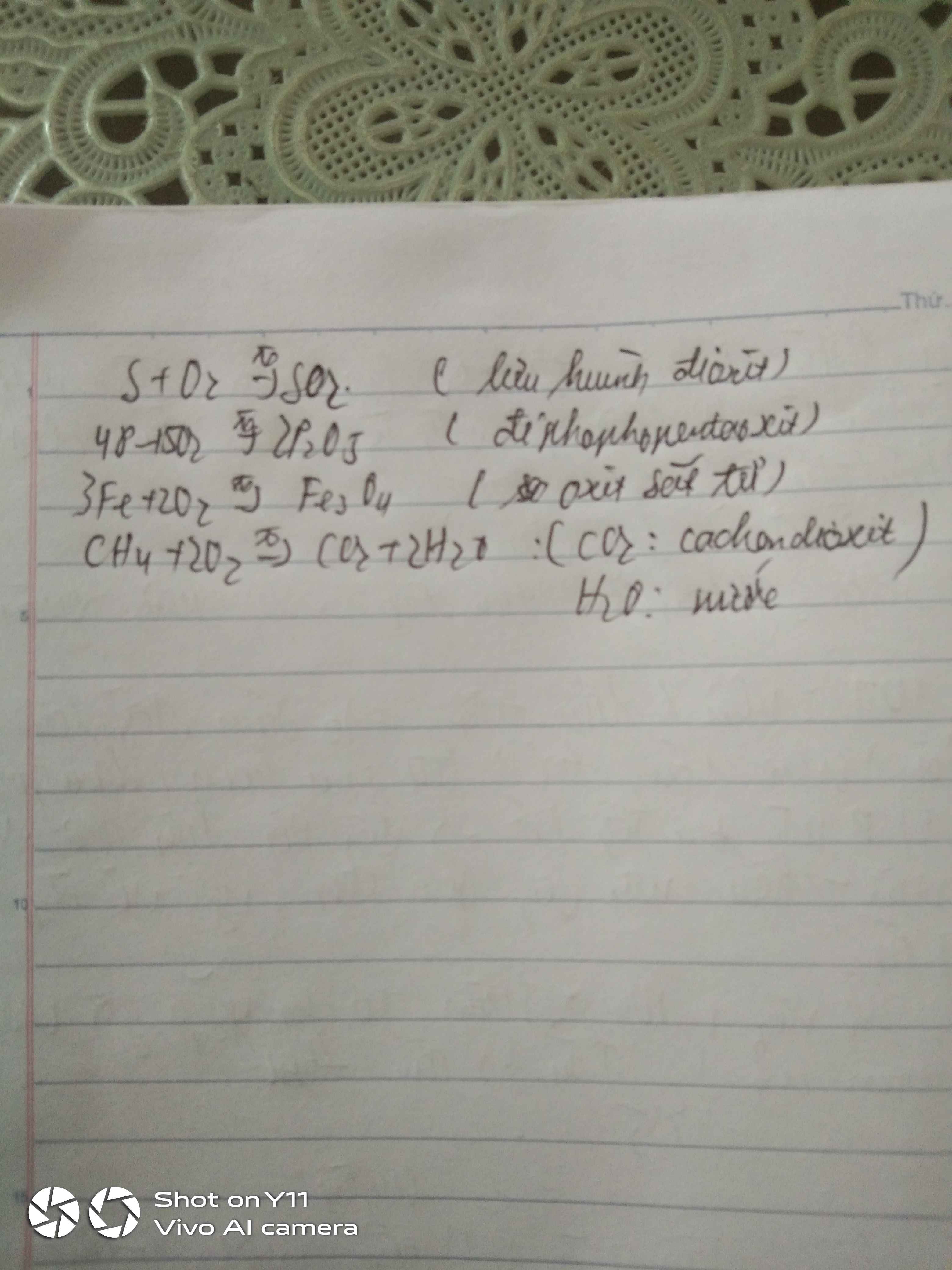Viết các PTHH biểu diễn sự cháy trong oxi của các chất sau trong oxi: Lưu huỳnh, photpho, sắt, nhôm, metan. Gọi tên các chất sản phẩm.
Hãy nhập câu hỏi của bạn vào đây, nếu là tài khoản VIP, bạn sẽ được ưu tiên trả lời.


\(C+O_2\underrightarrow{t^0}CO_2\) ( Cacbon dioxit)
\(4P+5O_2\underrightarrow{t^0}2P_2O_5\)( Diphotpho pentaoxit)
\(H_2+\dfrac{1}{2}O_2\underrightarrow{t^0}H_2O\) ( Nước hay dihidro monooxit)
\(4Al+3O_2\underrightarrow{t^0}2Al_2O_3\) ( Nhôm oxit)

\(S+O_2\rightarrow\left(t^o\right)SO_2\\ 4Al+3O_2\rightarrow\left(t^o\right)2Al_2O_3\\ 2Mg+O_2\rightarrow\left(t^o\right)2MgO\)
Đọc tên sản phẩm:
SO2 : Lưu huỳnh dioxit
Al2O3: Nhôm oxit
MgO: Magie oxit

C + O2  CO2. Cacbon đioxit.
CO2. Cacbon đioxit.
4P + 5O2  2P2O5. Điphotpho pentaoxit.
2P2O5. Điphotpho pentaoxit.
2H2 + O2  2H2O. Nước.
2H2O. Nước.
4Al + 3O2  2Al2O3. Nhôm oxit.
2Al2O3. Nhôm oxit.

\(Na+O_2-^{t^o}\rightarrow Na_2O\left(Natrioxit\right)\\ 4P+5O_2-^{t^o}\rightarrow2P_2O_5\left(Điphốtphopentaoxit\right)\\ 4Al+3O_2-^{t^o}\rightarrow2Al_2O_3\left(Nhômoxit\right)\)
Tất cả phản ứng trên đều thuộc loại phản ứng hóa hợp

Bài 8:
\(V_{O_2}=20.100=2000\left(ml\right)=2\left(l\right)\\ a,PTHH:2KMnO_4\rightarrow\left(t^o\right)K_2MnO_4+MnO_2+O_2\\ n_{O_2}=\dfrac{2}{22,4}=\dfrac{5}{56}\left(mol\right)\\ n_{O_2\left(p.ứ\right)}=\dfrac{5}{56}.90\%=\dfrac{9}{112}\left(mol\right)\\ n_{KMnO_4\left(dùng\right)}=\dfrac{9}{112}.2=\dfrac{9}{56}\left(mol\right)\\ \Rightarrow m_{KMnO_4}=\dfrac{9}{56}.158=\dfrac{711}{28}\left(g\right)\\ b,2KClO_3\rightarrow\left(t^o,xt\right)2KCl+3O_2\\ n_{KClO_3}=\dfrac{2}{56}.\dfrac{2}{3}=\dfrac{1}{42}\left(mol\right)\\ m_{KClO_3}=122,5.\dfrac{1}{42}=\dfrac{35}{12}\left(g\right)\)
Bài 1:
\(C+O_2\rightarrow\left(t^o\right)CO_2\)
Tên sản phẩm: Cacbon dioxit/ Khí cacbonic
\(4P+5O_2\rightarrow\left(t^o\right)2P_2O_5\)
Tên sản phẩm: Điphotpho pentaoxit
\(2H_2+O_2\rightarrow\left(t^o\right)2H_2O\)
Tên sản phẩm: Nước
\(4Al+3O_2\rightarrow\left(t^o\right)2Al_2O_3\)
Tên sản phẩm: Nhôm oxit

\(4Al+3O_2\underrightarrow{t^0}2Al_2O_3\)
\(4Fe+3O_2\underrightarrow{t^0}2Fe_2O_3\)
\(C+O_2\underrightarrow{t^0}CO_2\)
\(4P+5O_2\underrightarrow{t^0}2P_2O_5\)
Phương trình phản ứng theo thứ tự là:
1) 4Al + 3O2 → 2Al2O3.
2) 3Fe + 2O2 → Fe3O4.
3) C + O2 → CO2.
4) P + O2 → P2O5.

3Fe + 2O2 -to-> Fe3O4
S + O2 -to-> SO2
CH4 + 2O2 -to-> CO2 + 2H2O

\(4Al+3O_2\xrightarrow[]{t^o}2Al_2O_3\) : Nhôm oxit
\(4Fe+3O_2\xrightarrow[]{t^o}2Fe_2O_3\) : Sắt (III) oxit
\(C+O_2\xrightarrow[]{t^o}CO_2\) : Cacbon đioxit
\(S+O_2\xrightarrow[]{t^o}SO_2\) : Lưu huỳnh đioxit
4Al + 3O2 → 2Al2O3 (đây là phản ứng hóa hợp vì chỉ có 1 chất sản phẩm)( tên : Nhôm oxit)
3Fe + 2O2 → Fe3O4 (đây là phản ứng hóa hợp vì chỉ có 1 chất sản phẩm) (tên là oxit sắt từ hoặc Sắt (2,3)oxit)bạn ghi số la mã hộ mk nha
C + O2 → CO2 (là phản ứng hóa hợp vì chỉ có 1 chất sản phẩm)(tên là cacbon đi oxit)
S + O2 → SO2(là phản ứng hóa hợp vì chỉ có 1 chất sản phẩm)(tên : lưu huỳnh đi oxit
TẤT CẢ PT TRÊN BẠN GHI THÊM NHIỆT ĐỘ K SAI NHA

S + O2 -to-> SO2
4P + 5 O2 -to-> 2 P2O5
3 Fe + 2 O2 -to-> Fe3O4
4 Al + 3 O2 -to-> Al2O3
CH4 + 2 O2 -to-> CO2 + 2 H2O